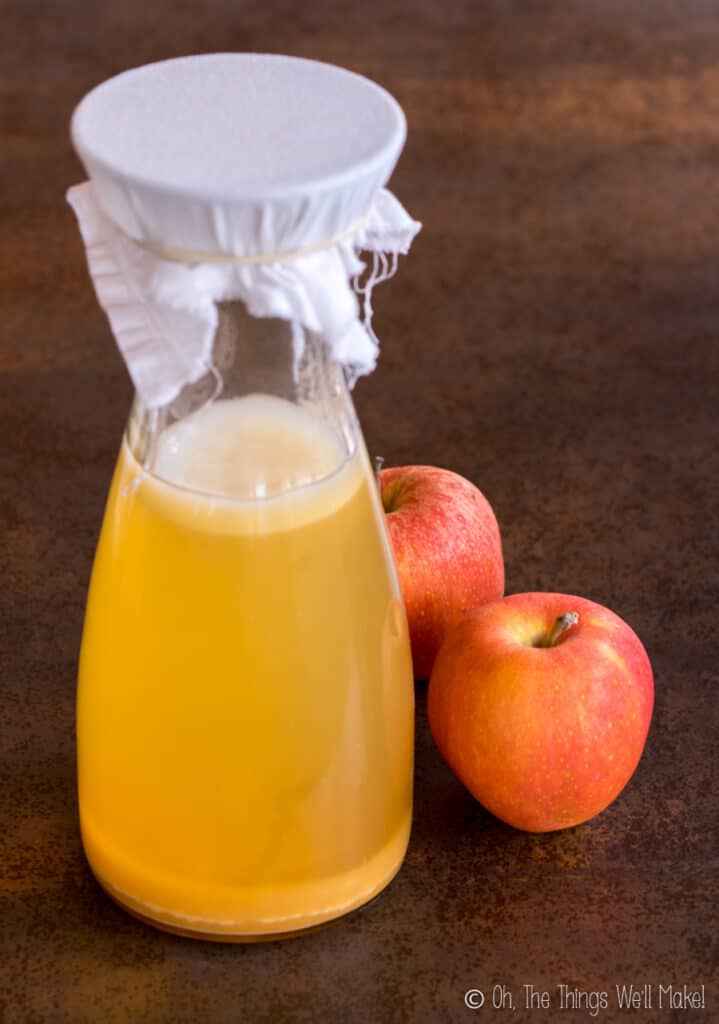Apple cider vinegar has been touted as a cure-all for everything from weight loss to dandruff.
But did you know that it’s also incredibly easy and affordable to make at home?
In this article, we’ll walk you through the steps of making your own apple cider vinegar, so you can enjoy its benefits without breaking the bank.

What You Need
Before we dive into the process of making apple cider vinegar, let’s talk about what you’ll need:
Equipment and Ingredients
- A glass jar or bottle with a wide mouth (at least 1 litre in size)
- Organic apples (enough to fill the jar about 3/4 full)
- Sugar (about 1 tablespoon per cup of water)
- Purified water
- A cheesecloth or coffee filter
Preparing the Apples
Wash the apples thoroughly and cut them into small pieces.
Remove any stems or seeds.
Making the Cider
Place the apple pieces in the jar and add enough water to cover them.
Stir in the sugar until it dissolves.
Cover the jar with the cheesecloth or coffee filter and secure it with a rubber band.
Store the jar in a warm, dark place for about 2 weeks, stirring the mixture every few days.
⇒Tip: Make sure the apples are completely submerged in the water to prevent mould from forming.
Straining and Fermenting
After 2 weeks, strain the mixture through the cheesecloth or coffee filter into a clean jar.
Cover the jar again with the cheesecloth or coffee filter and let it sit for another 4-6 weeks, stirring occasionally.
The mixture will start to ferment and turn into vinegar.
⇒Tip: The longer you let the mixture ferment, the stronger the vinegar will be.
Storing and Using
Once the vinegar has reached your desired strength, transfer it to a clean bottle or jar and store it in a cool, dark place.
You can use it for cooking, cleaning, or even as a natural remedy for
The Process of Making Apple Cider Vinegar

Now that you have everything you need, it’s time to get started!
Step 1: Preparing the Apples
- Wash the apples thoroughly and chop them into small pieces.
- You don’t need to remove the seeds or stems.
- Fill the jar about 3/4 full with the chopped apples
Did you know that the type of apple you use will affect the flavour of your vinegar?
Try experimenting with different varieties to find your favourite.
Step 2: Adding Sugar and Water
- Add enough sugar to cover the apples.
- The amount of sugar you need will depend on the size of your jar, but a good rule of thumb is about 1 tablespoon per cup of water.
- Fill the jar with purified water, leaving about an inch of space at the top
Using purified water is important because tap water can contain chlorine and other chemicals that can interfere with the fermentation process.
Step 3: Fermenting the Mixture
- Cover the jar with cheesecloth or coffee filter and secure it with a rubber band.
- This will allow air to flow in and out of the jar while keeping out any debris or insects.
- Store the jar in a cool, dark place for about 2 weeks.
- Stir the mixture every few days to ensure that all of the apples are submerged.
- After 2 weeks, strain out the apple pieces and return the liquid to the jar
Be patient during the fermentation process; it can take longer than 2 weeks for the mother to form on top of the liquid.
Step 4: Forming the Mother
- Cover the jar again with the cheesecloth or coffee filter and let it sit for another 4-6 weeks.
- During this time, a film called the mother will form on top of the liquid.
- This is a good thing; it means your vinegar is fermenting properly!
The mother is made up of beneficial bacteria and enzymes that give apple cider vinegar its health benefits.
Step 5: Tasting and Bottling the Apple Cider Vinegar
- After 4-6 weeks, taste your vinegar.
- If it’s too sour for your liking, you can dilute it with water until it reaches your desired level of acidity.
- Bottle your vinegar and store it in a cool, dark place.
- It should last for several months.
Homemade apple cider vinegar can be used in a variety of recipes, from salad dressings to marinades to cleaning solutions.
Tips and Tricks

Making apple cider vinegar is a simple process, but there are a few things you can do to ensure success:
Use Organic Apples
Use organic apples whenever possible.
Conventionally grown apples may have pesticides or other chemicals on their skin that could interfere with the fermentation process.
Don’t Worry About Cloudiness
Don’t worry if your vinegar looks cloudy or has sediment at the bottom.
This is normal and doesn’t affect the quality of the vinegar.
Skim Off Mould
If mould develops on the surface of your vinegar during the fermentation process, don’t panic!
Simply skim off the mould and continue as normal.
Reuse the Mother
You can reuse the mother from one batch of vinegar to start another.
Simply add it to your new batch along with some fresh sugar and chopped apples.
Using organic apples is important to avoid pesticides and chemicals that could interfere with the fermentation process.
Cloudiness and sediment in your vinegar are normal and don’t affect the quality of the vinegar.
If mould develops on the surface of your vinegar, simply skim it off and continue as normal.
Fruits That Can Be Fermented – Discover Now! ⇒ READ MORE
The Benefits of Apple Cider Vinegar

Now that you know how to make your own apple cider vinegar, let’s talk about why you should bother.
Here are just a few of the many benefits of this magical elixir:
Regulates Blood Sugar and Improves Insulin Sensitivity
Apple cider vinegar can help regulate blood sugar levels and improve insulin sensitivity, making it a great choice for people with diabetes or pre-diabetes.
Aids in Weight Loss
Apple cider vinegar may aid in weight loss by increasing feelings of fullness and reducing appetite.
Antimicrobial Properties
Apple cider vinegar has antimicrobial properties that can help fight off harmful bacteria and viruses.
⇒Apple cider vinegar can be used as a natural disinfectant for household surfaces.
Improves Digestion
Apple cider vinegar can soothe an upset stomach and improve digestion.
Reduces Risk of Heart Disease
Apple cider vinegar may help lower cholesterol and triglyceride levels, reducing the risk of heart disease.
- It is important to dilute apple cider vinegar before consuming it, as it can be harmful to tooth enamel and the throat
- Apple cider vinegar should not be used as a replacement for medical treatment or medication
- It is always best to consult with a healthcare professional before adding apple cider vinegar to your diet
⇒Apple cider vinegar should not be used as a cure-all and should be consumed in moderation.
The Bottom Line:
Making your own apple cider vinegar is a fun and rewarding process that can save you money while providing you with a high-quality product.
With just a few simple ingredients and some patience, you can have your very own homemade vinegar that’s packed with health benefits.
So what are you waiting for?
Give it a try today!
